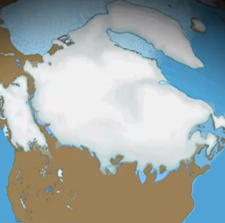Ice Ages
Ocean Circulation During Ice Ages
During most of the last million years, global temperatures were significantly colder than they are today. Ice encroached further toward the equator, sea level was lower, and wind patterns were altered. At the last glacial maximum, some 20 thousand years ago, where Chicago, Stockholm, and Glasgow now stand, ice was more than 1 km thick, indicating that the global climate was radically different from what it is today.
Paleorecords suggest that ocean circulation during the last ice age was less stable than it has been during the last 10,000 years. Changes in ocean circulation patterns may have led to, or may have been caused by, dramatic changes in high-latitude temperatures, sea ice coverage, and precipitation patterns.
Researchers at MIT and WHOI are using a combination of data and models to understand the drivers and impacts of these rapid changes in ocean circulation—in part, to determine whether the future holds similar instability.
The Ocean’s Role in Atmospheric CO2 Changes
During the recurring ice ages of the last 800 thousand years, approximately 1/3 of the CO2 that was in the atmosphere during warm interglacial periods was drawn down into the deep ocean. Understanding the mechanisms of this natural carbon sequestration experiment remains a major research goal.
Increased storage of CO2 in the ocean during ice ages reflects a combination of factors, including cooling of the global ocean; changes in ocean circulation and sea ice coverage in the Southern Ocean; and increased supply of iron from windblown dust, leading to more complete consumption of nutrients in the Southern Ocean and a stronger ‘biological pump’ moving carbon into the deep sea. To analyze the impact of future changes on carbon storage in the deep sea, as well as the viability of carbon sequestration schemes involving the ocean, it is critical that we have a better understanding of the past behavior of these mechanisms.
Key Questions We’re Exploring:
- How was ocean circulation different during ice ages and why?
- Can models produce ocean circulation patterns that are consistent with both data and our understanding of climate dynamics?
- How did iron supplied by windblown dust during ice ages affect the ocean’s biological communities and the sequestering of carbon in the deep ocean?







